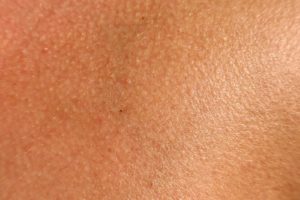 When we think about air pollution, we usually think about pollutants in the air that we breathe in. But there is a growing body of evidence that some pollutants found in the air, including a group of chemicals called phthalates, can be absorbed directly through the skin (dermal absorption or dermal intake). A recent study has found that the skin absorption of certain phthalates (DERP and DnBP) is comparable to that from inhalation.
When we think about air pollution, we usually think about pollutants in the air that we breathe in. But there is a growing body of evidence that some pollutants found in the air, including a group of chemicals called phthalates, can be absorbed directly through the skin (dermal absorption or dermal intake). A recent study has found that the skin absorption of certain phthalates (DERP and DnBP) is comparable to that from inhalation.
Phthalates are linked to a number of negative health effects, and so we should try to minimize our exposure to them.(Oct. 8, 2015 post and Sept. 29, 2015 post). The findings of this study is another strong argument against using scented products in the home, because phthalates are found in fragrances - whether air fresheners, scented candles, perfumes, dryer sheets, etc. Just think of them as indoor air pollution. From Environmental Health Perspectives:
Fundamental considerations indicate that, for certain phthalate esters, dermal absorption from air is an uptake pathway that is comparable to or greater than inhalation. Yet this pathway has not been experimentally evaluated and has been largely overlooked when assessing uptake of phthalate esters.This study investigated transdermal uptake, directly from air, of diethyl phthalate (DEP) and di(n-butyl) phthalate (DnBP) in humans.
In a series of experiments, six human participants were exposed for 6 hr in a chamber containing deliberately elevated air concentrations of DEP and DnBP. The participants either wore a hood and breathed air with phthalate concentrations substantially below those in the chamber or did not wear a hood and breathed chamber air. All urinations were collected from initiation of exposure until 54 hr later. Metabolites of DEP and DnBP were measured in these samples and extrapolated to parent phthalate intakes, corrected for background and hood air exposures. For DEP, the median dermal uptake directly from air was 4.0 μg/(μg/m3 in air) compared with an inhalation intake of 3.8 μg/(μg/m3 in air). For DnBP, the median dermal uptake from air was 3.1 μg/(μg/m3 in air) compared with an inhalation intake of 3.9 μg/(μg/m3 in air).
This study shows that dermal uptake directly from air can be a meaningful exposure pathway for DEP and DnBP. For other semivolatile organic compounds (SVOCs) whose molecular weight and lipid/air partition coefficient are in the appropriate range, direct absorption from air is also anticipated to be significant.
Selected phthalates have been associated with multiple health effects, including children’s neurodevelopment (Kim Y et al. 2011; Whyatt et al. 2012), altered genital development (Swan et al. 2005), respiratory problems (Jaakkola and Knight 2008), oxidative stress (Ferguson et al. 2011), obesity (Hatch et al. 2010), and the development of diabetes (Svensson et al. 2011). Phthalates are used in a wide variety of consumer products (Dodson et al. 2012), and their metabolites are commonly found in human urine (Koch et al. 2011; Langer et al. 2014; Zota et al. 2014)..... Numerous experimental studies have demonstrated that certain volatile organic compounds (VOCs) are dermally absorbed from air at rates that are comparable to their intake via inhalation (e.g.,Bader et al. 2008; Piotrowski 1967, 1971; other references in Weschler and Nazaroff 2014).
Diethyl phthalate (DEP) and di(n-butyl) phthalate (DnBP) are among the SVOCs predicted to have substantial dermal uptake directly from air (Weschler and Nazaroff 2012, 2014).... DEP is used in personal care products such as cosmetics, perfumes, and shampoos; it is also used in the automotive sector and food packaging. DnBP is a common ingredient of adhesives and coatings and is used as a solvent for organic compounds, as an antifoam agent, as a fiber lubricant, and as an additive in cosmetics, including nail polish (Bolgar et al. 2008; Dodson et al. 2012; Wypych 2012). DEP and DnBP have been identified in indoor air and dust samples from around the world (e.g., Fromme et al. 2004; Rudel et al. 2003; Wensing et al. 2005; Weschler and Nazaroff 2008). Their metabolites are often the most abundant synthetic chemicals identified in human urine (Koch et al. 2011; Langer et al. 2014; Zota et al. 2014).
The older the participant, the higher were the dermal uptakes of both DEP and DnBP from air. Based on this limited sample of six, the impact of age is surprisingly strong. The uptake of DEP by the 66-year-old is five times greater than that of the 27-year-old, while the uptake of DnBP is seven times greater....They indicate that the trend for increased dermal uptake with increasing age is significant for DEP and DnBP, whereas the trend for increased inhalation uptake is significant for DnBP, but not DEP....In the present study the human participants wore only shorts; the rest of their skin was directly exposed to air.
